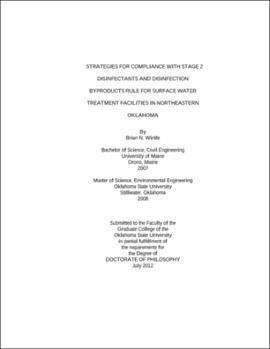| dc.contributor.advisor | Wilber, Gregory G. | |
| dc.contributor.author | Wintle, Brian N. | |
| dc.date.accessioned | 2013-12-10T18:05:35Z | |
| dc.date.available | 2013-12-10T18:05:35Z | |
| dc.date.issued | 2012-07 | |
| dc.identifier.uri | https://hdl.handle.net/11244/7841 | |
| dc.description.abstract | Scope and Method of Study: The Environmental Protection Agency (EPA) recently created new regulations that better protect human health but that also make achieving compliance more difficult for existing water treatment facilities. Compliance with the Stage 2 Disinfectants and Disinfection Byproducts (D/ DBPs) Rule will become increasingly more difficult for surface water treatment facilities in northeastern Oklahoma. Technologies exist for compliance with Stage 2 D/ DBP Rule for all systems in northeastern Oklahoma. Stage 2 D/ DBP Rule compliance strategies that were evaluated were: the use of chlorine dioxide, ozone, and ultraviolet light; the use of chloramines as a microorganism barrier in the distribution system; and the use of total organic carbon removal technologies. | |
| dc.description.abstract | Findings and Conclusions: Due to capital and operational costs, chloramines will be the most likely selected compliance technology for water authorities in northeastern Oklahoma. The compliance technology should not be based exclusively on cost, but rather selection should incorporate all facets of water treatment. Selection of a compliance technology should be based on the best solution specific to each individual water authority. Investigations were conducted into developing decision trees that can be used by water authorities in northeastern Oklahoma and ODEQ for preliminary determination of compliance technologies. Water authorities should strive to meet a LRAA that is consistently below the 40/ 30 limit (40 µg/L of TTHMs and 30 µg/L HAA5s). Water authorities should also be aware of the potential future regulations drinking water regulations, especially the DBPs that are more likely to be formed by chloramines. | |
| dc.format | application/pdf | |
| dc.language | en_US | |
| dc.rights | Copyright is held by the author who has granted the Oklahoma State University Library the non-exclusive right to share this material in its institutional repository. Contact Digital Library Services at lib-dls@okstate.edu or 405-744-9161 for the permission policy on the use, reproduction or distribution of this material. | |
| dc.title | Strategies for compliance with stage 2 Disinfectants and Disinfection Byproducts Rule for surface water treatment facilities in northeastern Oklahoma | |
| dc.contributor.committeeMember | Veenstra, John N. | |
| dc.contributor.committeeMember | McTernan, William F. | |
| dc.contributor.committeeMember | Sanders, Dee Ann | |
| dc.contributor.committeeMember | Foutch, Gary Lynn | |
| osu.filename | Wintle_okstate_0664D_12247.pdf | |
| osu.accesstype | Open Access | |
| dc.type.genre | Dissertation | |
| dc.type.material | Text | |
| dc.subject.keywords | compliance | |
| dc.subject.keywords | hpsec | |
| dc.subject.keywords | ndma | |
| dc.subject.keywords | northeastern oklahoma | |
| dc.subject.keywords | stage 2 d/ dbp rule | |
| thesis.degree.discipline | Civil Engineering | |
| thesis.degree.grantor | Oklahoma State University | |
